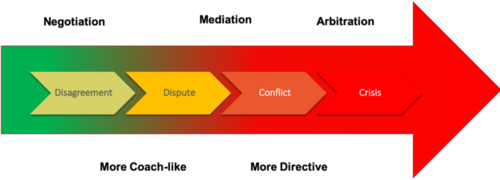Courageous Conversations: Difference between revisions
Carin Hunter (talk | contribs) No edit summary |
Carin Hunter (talk | contribs) No edit summary |
||
| Line 4: | Line 4: | ||
The Rehab Leadership Framework - 7 leadership | The Rehab Leadership Framework - 7 leadership skilled | ||
at the centre of a person and our leadership performance lies our personal values and beliefs. Personal values and beliefs are fundamental to who we are as humans and dramatically influence how we show up in leadership situations | at the centre of a person and our leadership performance lies our personal values and beliefs. Personal values and beliefs are fundamental to who we are as humans and dramatically influence how we show up in leadership situations | ||
| Line 12: | Line 12: | ||
the bar on model of emotional intelligence contains five main composites and 15 subscales. Now, interestingly, a number of the emotional intelligence subscales are critical for a successful courageous conversation to occur. These include: self-regard, self-actualisation, emotional self-assessment, emotional expression, assertiveness, interpersonal relationships, empathy, problem solving, reality testing, impulse control, flexibility and stress tolerance. | the bar on model of emotional intelligence contains five main composites and 15 subscales. Now, interestingly, a number of the emotional intelligence subscales are critical for a successful courageous conversation to occur. These include: self-regard, self-actualisation, emotional self-assessment, emotional expression, assertiveness, interpersonal relationships, empathy, problem solving, reality testing, impulse control, flexibility and stress tolerance. | ||
Revision as of 20:48, 26 May 2021
the leader has a goal or a desired outcome that needs to be achieved within the discussion. Maybe a behaviour change, a specific action needs to happen, or possibly just a change in attitude. Yet being open, authentic, and honest while maintaining an atmosphere of trust and respect can be daunting for many leaders.
Well, about half of all people who find themselves in a courageous conversation, find it most difficult to start the discussion off on the right foot or begin well.
The Rehab Leadership Framework - 7 leadership skilled
at the centre of a person and our leadership performance lies our personal values and beliefs. Personal values and beliefs are fundamental to who we are as humans and dramatically influence how we show up in leadership situations
wrapping around our personal values and beliefs, the next key aspect to our leadership effectiveness is emotional intelligence or the way in which we recognise, understand and manage emotions in order to develop or maintain social relationships and cope with challenges
the bar on model of emotional intelligence contains five main composites and 15 subscales. Now, interestingly, a number of the emotional intelligence subscales are critical for a successful courageous conversation to occur. These include: self-regard, self-actualisation, emotional self-assessment, emotional expression, assertiveness, interpersonal relationships, empathy, problem solving, reality testing, impulse control, flexibility and stress tolerance.
personal values, beliefs, and emotional intelligence form the heart of leadership effectiveness and create a foundation upon which we can build practical leadership skills. The seven leadership skills around the outer rim of the rehab leadership framework are essential to effective leadership in rehab and can be successfully developed on a firm foundation of personal values, beliefs, and emotional intelligence. Now our focus in this course will be on the practical leadership skills of effective communication, coaching and mentoring, and managing conflict.
At one end we have disagreement, a difference of opinion. In this situation, the leader focuses on negotiation and compromise. Coaching the disagreeing parties to come to a win-win resolution. At times, this disagreement advances further and becomes a dispute. The leader shifts her approach becomes more of a mediator than a coach, trying to find common ground between the two opponents by asking questions and making suggestions. Now many conflicts are resolved at this stage and the two individuals find a way to move forward with an agreement. Yet at times the interaction heats up and becomes a full-blown conflict. As this happens, the leader shifts into an increasingly more directive and less coach-like approach. If things continue worsening the interaction shifts into a crisis situation. By now emotions are boiling over and the situation could become emotionally, psychologically, or physically unsafe. The leader becomes fully directive and may shift into a formal arbitration approach where each of the participants has representation. They may or may not be able to stay in the same physical space, and so on. The key message here is that as conflict advances or retreats, the leader must match his approach to the situation. Most times, once the interaction moves beyond dispute. A courageous conversation is unlikely to be effective. In fact, without a third party assisting with a discussion, a courageous conversation may actually worsen the situation and ignite additional frustration. So before you dive in, I suggest you pause, assess the situation and consider where things are at on the conflict continuum
assessing the situation
Now in step one of this activity, think about a situation in your work or home life where a courageous conversation may be required. Describe that situation in the space provided. Now in step two, identify where the situation would likely land on the conflict continuum with an X on the graphic provided. Then in step three, consider whether the situation is the right fit for a courageous conversation, or whether a different approach may be required. We want to be sure to match the right leadership approach to the situation. Okay. That's activity one, quick and easy.








